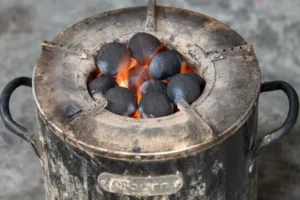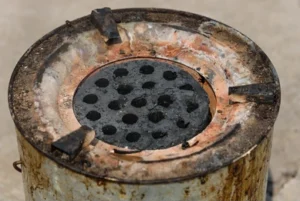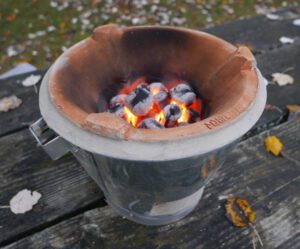Charcoal Briquette Stoves
- Charcoal briquette stoves are devices used for cooking that utilize charcoal briquettes as a fuel source in many hotels for cooking.
- These stoves are designed to efficiently burn charcoal, providing a source of heat for cooking purposes as given in the post.
- They’re commonly used in various parts of the world where access to other forms of fuel might be limited or where charcoal is a cost-effective and readily available energy source.


Here are some key points about charcoal briquette stoves:
Functionality:
- Fuel Source: They use charcoal briquettes, which are made from compressed charcoal dust, wood chips, and various binders.
- Efficiency: Many modern charcoal stoves are designed to maximize fuel efficiency and reduce emissions.
- Cooking Performance: They generate significant heat and are capable of cooking various types of food effectively.
- Portability: Some models are designed for portability, making them suitable for outdoor activities like camping or picnics.

Types of Charcoal Stoves:
- Traditional Stoves: These are often simple, traditional designs made from basic materials and used in many households, particularly in regions with limited access to other fuel sources.
- Improved Stoves: There are more advanced, improved versions designed for better efficiency and reduced emissions. These stoves often have better insulation and combustion systems.
- Eco-friendly Stoves: Some newer designs focus on minimizing the environmental impact by reducing smoke and emissions as used barbeque charcoal grills.

Tao Charcoal Stoves
- Tao Charcoal stoves are a type of Thailand cooking device that uses charcoal as their primary fuel source.
- They are commonly used in various parts of the world, especially in regions where other energy sources such as electricity or gas might be less accessible or affordable.
- These stoves are designed to cook food through the combustion of charcoal briquettes


Advantages Charcoal Stoves
- Readily Available Fuel: Charcoal is often easily accessible and cost-effective in many places.
- High Heat Output: Charcoal can produce high and consistent heat for cooking.
- Versatility: Charcoal stoves can be used for various types of cooking.
- Cost-Effective: Charcoal briquettes are often less expensive than other fuels, making these stoves an economical choice for many households.
- Energy Efficiency: Charcoal briquette stoves are relatively efficient, as they can produce a steady and consistent heat source for cooking and heating.
- Accessibility: Charcoal briquettes are widely available in many parts of the world, making them a convenient fuel source for communities with limited access to other energy options.
- Portability: Many charcoal stoves are compact and portable, which is useful for outdoor cooking, picnics, and camping.
- Reduced Smoke Emissions: Some modern charcoal stoves are designed to minimize smoke emissions, which can be a health hazard when using traditional open fires for cooking.
- Environmental Benefits: Charcoal briquettes are often produced from renewable resources, such as wood, and can be considered more environmentally friendly than some other fossil fuels.
Drawbacks to charcoal briquette stoves
However, there are also some drawbacks to charcoal briquette stoves:
- Air Pollution: Traditional charcoal stoves can produce significant indoor and outdoor air pollution due to incomplete combustion. This can have negative health impacts, particularly in poorly ventilated areas.
- Deforestation: In some regions, the production of charcoal for briquettes can lead to deforestation and habitat destruction.
- Carbon Emissions: While charcoal is a renewable resource, its production and use can still contribute to carbon emissions, which can have environmental consequences.
- Ash Residue: Charcoal stoves produce ash, which requires regular cleaning and disposal.
- Heat Control: It can be challenging to control the heat output of a charcoal stove, which may not be as precise as electric or gas stoves.
Environmental Impact and Solutions:
- Emissions: Traditional charcoal stoves can produce smoke and indoor air pollution.
- Environmental Impact: Charcoal production can contribute to deforestation and environmental degradation.
- Efforts are being made to address the environmental concerns associated with both charcoal production and usage.
- Initiatives include promoting sustainable charcoal production methods, creating more efficient stoves to reduce charcoal consumption, and developing stoves that minimize emissions and air pollution.
Conclusion:
- Charcoal briquette stoves are valuable in areas where other fuel sources might be scarce or costly.
- Efforts are ongoing to improve their efficiency, reduce emissions, and mitigate environmental impact, making them a more sustainable option for cooking.
- Different regions and organizations are working on enhancing the design and efficiency of these stoves to make them more environmentally friendly while providing an affordable and effective means of cooking for households.
Reference
- Charcoal Briquette Stove in Thailand
